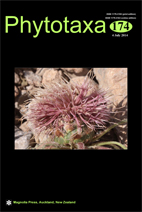Abstract
Kuruna, a new temperate woody bamboo (Poaceae, Bambusoideae, Arundinarieae) genus from Sri Lanka, is recognized based on chloroplast sequence data from five markers (coding: ndhF 3’ end; non-coding: rps16-trnQ, trnC-rpoB, trnD-trnT, trnT-trnL). This genus represents the twelfth major lineage of temperate woody bamboos and is characterized by pachymorph culm bases with short necks, unicaespitose clumps, culm leaf girdles ca. 1 mm wide, usually abaxially hispid culm leaves with non-irritating hairs, persistent foliage leaf sheaths, complete branch sheathing and acute to biapiculate palea apices. Maximum Parsimony, Bayesian Inference and Maximum Likelihood analyses of a combined data set consistently strongly supported the monophyly of this Sri Lankan temperate woody bamboo clade. Although the Kishino-Hasegawa test is unable to reject the alternative hypothesis of monophyly of the Sri Lankan clade plus Bergbambos tessellata from South Africa, Kuruna and Bergbambos are distinguishable by a combination of morphological characters. A few additional cpDNA markers not previously used in phylogenetic analyses of Arundinarieae were tested to evaluate their utility in this taxonomically difficult tribe.

